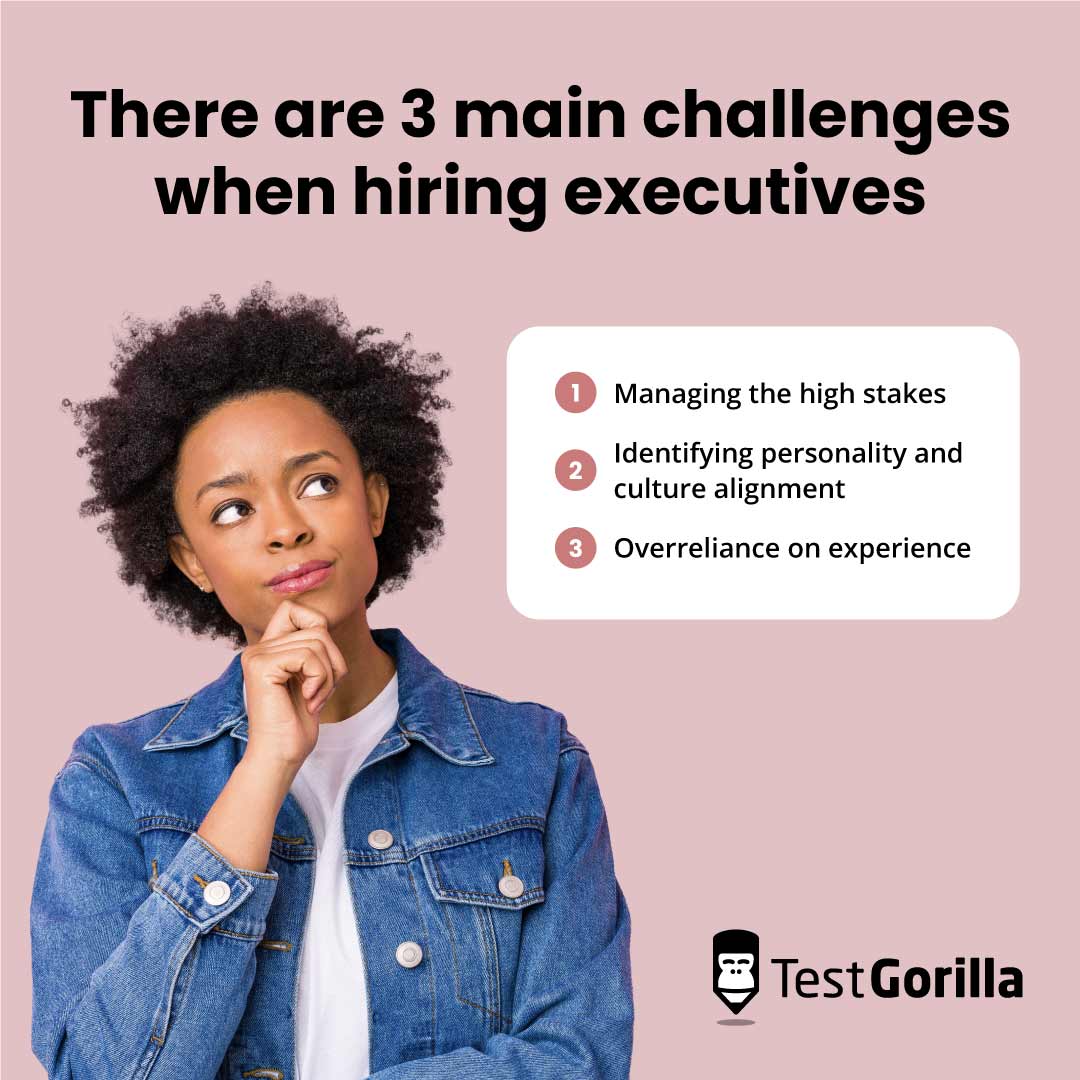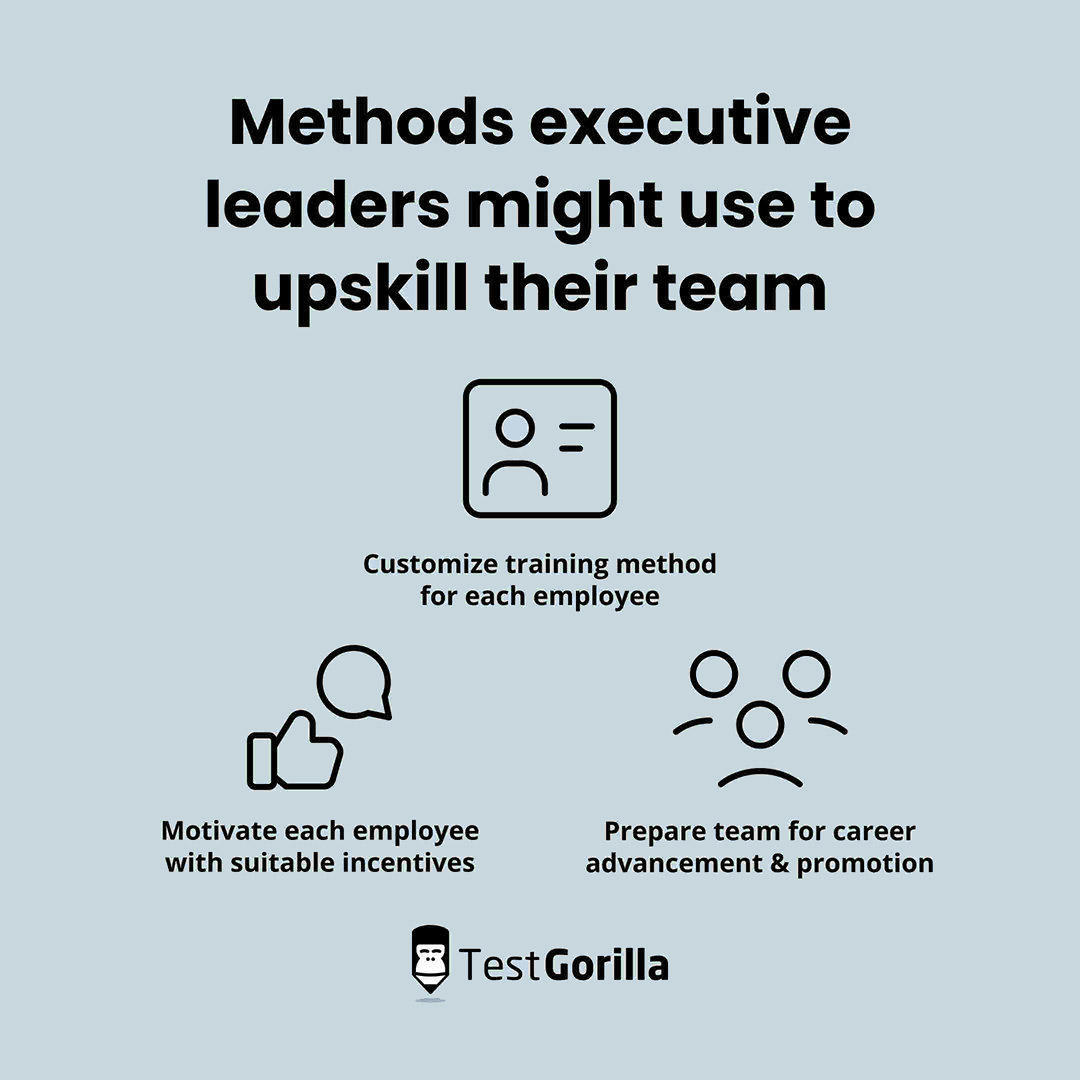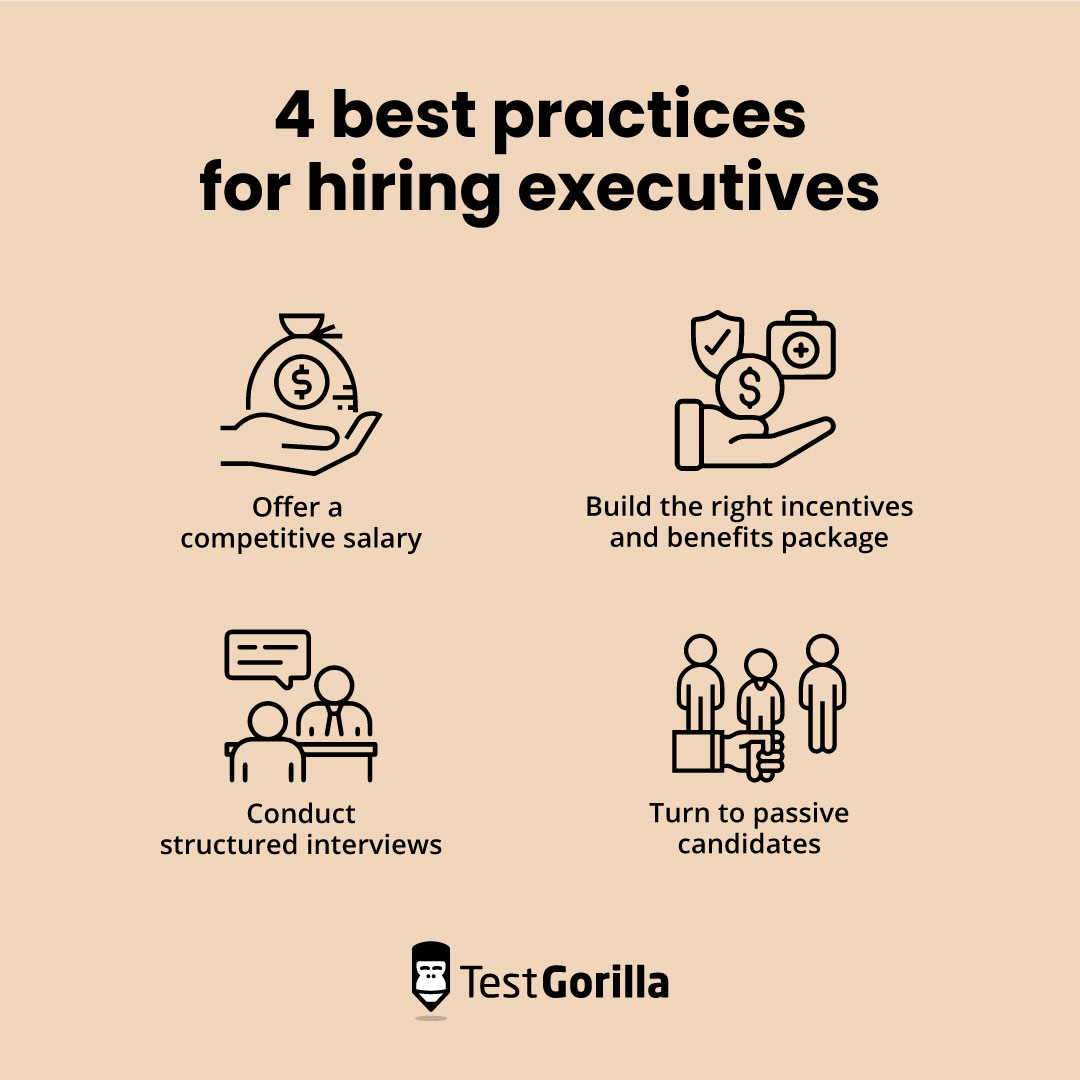Hiring executive leaders is arguably the most significant recruitment process a company engages in.
Senior leadership plays a crucial role in driving productivity, innovation, and culture – so the stakes couldn’t be higher for hiring teams.
By using talent assessments, stakeholders in your hiring process can quickly evaluate prospective executives based on their skills and personality.
Assessing them this way is far more objective and valuable than relying on time-consuming and biased processes like unstructured interviews and reliance on resumes.
Talent assessments focus on the expertise you need for executive roles, such as the skills you need to hire a business manager.
This blog discusses the best ways to use skill-based talent assessments to improve how you evaluate and recruit executives.
Table of contents
- What is executive hiring?
- The difficulties with recruiting senior-level employees
- How talent assessments help with hiring executives
- 8 ways to use talent assessments to optimize your recruitment strategy for senior-level executives
- Beyond talent assessments: 4 best practices to remember for hiring executives
- Make talent assessments your recruitment strategy for senior-level executives
What is executive hiring?
Executive hiring is the process of finding, assessing, and onboarding senior leaders in your company.
Unlike the more typical high volume hiring for junior and mid-level positions, your candidate pool usually only has 10 or fewer candidates for each position.
With the industry experience, niche skills, and strong leadership needed to become an executive, your candidates are in high demand.
For this reason, candidates for executive recruitment are often passive, meaning they’re technically employed and not publicly seeking opportunities.
That’s why many companies hire a headhunter, a recruiting firm, or an executive search firm to support them – their relationships with senior-level candidates who are currently employed are invaluable.
In some cases, your executive candidates may also be former high potentials or HiPos you developed specifically for management roles through upskilling.
Why is hiring executives important?
Hiring executives is important because the decision you make will define your business’s future.
There are major costs with any mis-hire or bad hire. Not hiring the right software developer affects productivity, slows down projects, and potentially affects the morale of your technical team.
But suppose your chief technical officer is a mis-hire – then, the negative impact is more far-reaching and can cost you up to 213% of their annual salary.
But on a more positive note, hiring effective leaders can catalyze your company's success.
For example, Rose Marcario, Patagonia’s former chief executive officer, led her team to the most prosperous times in the company’s history. Marcario quadrupled sales during her tenure with the company.
The main skills and traits to look for in executives
Let’s review some important skills and traits you can evaluate to identify effective candidates for your senior leadership team:
Relevant skills to look for when hiring executives: | Personality traits to evaluate in executive candidates: |
- Strategic planning - Data analysis - Communication | - Competitive - Accountable - Empathy - Resilience - Adaptability |
Before you start the hiring process, it’s important that everyone involved signs off on the skills and traits you’re looking for in the executive role – these might be tied to specific business and culture goals you’re working towards.
Although talent assessments can objectively evaluate skills, you can use personality tests to effectively gauge a candidate’s personality and how they might fit into the role and culture.
For example, where a candidate sits on the Big 5 (OCEAN) test can tell you a lot about their leadership styles.
The difficulties with recruiting senior-level employees
The hiring process for leadership roles comes with its own set of complex challenges – from navigating confidentiality and negotiations to minimizing bias when evaluating candidates with impressive reputations.
Here are the three main challenges you face when hiring executives:
Managing the high stakes
Identifying personality and culture alignment
Overreliance on experience
Hiring executives carries the highest stakes in a business
Hiring a new senior leader is the most important decision you’ll make this year – arguably, in several.
The ripple effect of a mis-hire at this level bleeds into your company’s long-term strategy, financial stability, employee morale, and relationships with investors.
Hiring teams dread these headaches and proceed carefully, so it’s no wonder the process for hiring a chief executive officer can take up to eight months.[1]
Other issues that make the process exhaustively long and disruptive include:
Confidentiality related to the executive’s previous employer
Rigorous vetting and stakeholder buy-in required at the executive level
The company’s overall strategic goals in making the hire
These issues affect executive recruitment in all industries, but some face specific challenges that contribute to the weight of these decisions.
Non-profits, for example, often have trouble hiring an executive director because they often can’t offer the same competitive salaries as private sector companies.[2]
This process may take much longer than non-executive hiring processes, and having a robust recruitment strategy that enables all stakeholders to work quickly and objectively is key.
Evaluating personality and culture alignment
More than 90% of executives believe a distinct culture is crucial to success, so it’s fair to say that your candidates value culture add just as much as you do.
But, problems arise when:
Employers mistake culture add for subjective “culture fit” evaluations that descend into a “beer test.” And you end up choosing candidates based on whether you like them rather than whether they can take your organization forward.
Employers fail to evaluate their leadership candidates for personality and culture add, letting on-paper success overshadow the importance of a leader’s values and behaviors.
Without factoring personality and culture add into your strategy, you might fail to make the best objective decision.
For example, a chief financial officer candidate may have an impressive reputation. Still, their resume and performance metrics don’t explain that they have a rough authoritarian leadership style that could damage relationships at your company.
It is hard to objectively evaluate personality from a resume. However, if you’re clear about what style of leadership you’re looking for, you can use personality tests, like the Enneagram test, to better assess your candidates’ personality.
Overreliance on experience
When hiring executives, you’ll undoubtedly be talking to candidates with impressive backgrounds.
But a stellar resume with a long list of achievements doesn’t guarantee that a candidate will be a successful leader at your company.
By focusing too much on years of experience as a proxy for skills, hiring managers can miss other important factors, such as:
Exposure to technological advancement: Relying on a candidate’s track record could result in selecting a seasoned executive who no longer has the up-to-date skill set required for a rapidly changing industry
Industry-specific knowledge: Prioritizing experienced candidates for executive roles could rule out promising leaders with more industry acumen
If they fall into the trap of focusing too heavily on experience, hiring teams won’t be able to objectively evaluate how candidates will perform within the specific requirements of the role.
How talent assessments help with hiring executives
Talent assessments objectively evaluate candidates' and employees' skills, aptitudes, and abilities.
They are fundamental for evaluating executive candidates based on their skills, personality, and culture add, which helps you make objective decisions, reduce dependency on resumes, and improve time-to-hire.
Let’s see how.
Assess soft skills, culture, and personality
Talent assessments can focus on traits that can be difficult to evaluate objectively, like soft skills and personality.
It’s important to rule out executive candidates from backgrounds where leadership lacked empathy and collaborative communication.
Even if they appear to be attractive candidates on paper, an executive candidate may aggressively push for results, micromanage, and talk down to employees because these behaviors were integral to the toxic culture of their previous company.[3]
Culture-add, communication, and personality tests help you gain a more rounded understanding of these candidates, so you can proceed only with candidates with the right leadership style.
When coupled with hard skills tests, these assessments give employers accurate insights into how executives approach their responsibilities and what motivates them.
Reduce mis-hires
We’ve established that mis-hires at the executive level are extremely costly to the health and potential of your organization.
According to TestGorilla’s State of Skills-Based Hiring 2022, 92.5% of organizations see a reduction in executive mis-hires with talent assessments.
In addition to reducing mis-hires, talent assessments reduce cost-to-hire and increase retention, which is particularly important when hiring senior leaders.
Reduce reliance on resumes, work history, and degrees
In the past, it was rare for businesses to consider hiring executives without degrees or a long work history in the role they were applying for.
However, this trend is changing. Companies reduced their degree requirements for 31% of senior-level positions in the past five years.
With its heavy reliance on resumes, work experience, and degrees, traditional hiring eliminates many qualified candidates who may have been skilled through alternative routes (STARs).
Testing skills, personality, and culture add, on the other hand, promotes diversity and inclusion, giving the right candidates the chance to show their capabilities.
Executives are more than just their resumes. They have life stories that shaped their personalities and taught them invaluable soft skills that make them inspiring and effective leaders.
It is hard to summarize in a resume the experience that a vice president of sales gained while completing multiple tours in Afghanistan to successfully perform his executive job.
Yet, after assessing their skills and holding a structured interview, their real achievements that qualify them for a C-suite level role emerge.
Improve time-to-hire
Time-to-hire is crucial when hiring executives. Hiring a chief executive officer can take up to eight months, which could leave your company without clear direction for the better part of a year.
You must fill senior management roles quickly, especially if no succession plan is available.
According to the same TestGorilla report, 91.4% of organizations saw a reduction in time-to-hire after using talent assessments during the executive recruiting process.
Ideally, however, make sure that you have a succession plan for your senior-level employees. A succession plan can use talent assessments to identify upskilling requirements and create a path for internal promotions.
8 ways to use talent assessments to optimize your recruitment strategy for senior-level executives
Talent assessments can be a powerful tool when hiring C-level executives.
Let’s look at eight ways you can use them to recruit the best talent.
How to use talent assessments to hire senior level executives
Strategies | What they do |
1. Use talent assessment to look for internal promotions | Upskill existing talent by assessing their skill gaps and providing training and development |
2. Assess culture to ensure leadership aligns well | Pick specific tests to evaluate executive candidates for culture add |
3. Use talent assessments to improve the candidate experience | Signal to candidates that your process is fair and objective |
4. Find the right candidates in your database of previous hiring initiatives | Apply what you know about former candidates’ capabilities to hire them for executive positions |
5. Ensure they have the high-level skills and match the role | Use a combination of talent assessments to cover all the position’s requirements |
6. Build job descriptions on real skills and competencies | Ensure that your executive job descriptions include skill requirements and are up-to-date |
7. Encourage feedback | Ask your candidates what they thought about your talent assessments |
8. Boost your employer brand with skill-based hiring | Use social media to show your commitment to skill-based hiring |
1. Use talent assessment to look for internal promotions
The first spot to consider when formulating your recruitment strategy for senior-level executives is internally.
Using skills testing routinely to determine skill gaps enables you to upskill employees, preparing them for internal recruiting for management positions.
Employee promotions are a great strategy for executive recruiting because your existing workers are already aligned with your culture and have the right skills and competencies.
They have also benefited from in-house employee training and development to hone their skills. Promotions can save costs and shorten time-to-hire because these candidates can start immediately and are familiar with your organization’s processes.
Talent assessments also help you with succession planning, which should be a part of your overall leadership development plan.
2. Assess culture add to ensure leadership alignment
Our Culture Add test enables you to assess executive candidates and ensure they are the right match for your organization.
Traditional hiring methods usually test for culture fit or how well the executive and their reputation fit into the existing culture.
Often, these tests are unstructured, which lets bias enter the equation and makes hiring decisions subjective.
Suppose you hire an executive because they are connected to your board of directors, for example, or highly recommended by them. If you don’t assess their culture properly, they might be an autocratic executive who destroys your egalitarian company culture.
Assessing culture add lets you gauge real skills and potential to add to your culture objectively.
Because the key role of executives is to promote and nurture your culture and values, they must align well with them from day one.
3. Use talent assessments to improve the candidate experience
Having a clear and streamlined hiring experience for executive candidates is especially important because they’re often not actively looking for a new position.
If executive candidates already have to juggle multiple responsibilities, they’ll be immediately put off by interruptions and delays caused by unnecessarily complex hiring processes.
Being clear about what the hiring process involves and letting them know you use skills tests can improve the candidate experience and:
Show them that you value objectivity and good decision-making
Show them that your assessments are fair
Show transparency, which can alleviate anxiety about skills tests
A good candidate experience for executive leaders makes your reputation stand out because applicants spread the word about your fair hiring practices across their networks.
4. Find the right candidates in your database of previous hiring initiatives
One of the benefits of using talent assessments is that you build a database of strong candidates to refer back to in future hiring rounds.
Use your database of previous executive candidates to pick those who showed great potential but were unsuccessful during previous executive recruiting initiatives.
You may have already tested them for culture add and found their skills perfect for an executive role.
These candidates are also already familiar with your hiring process and company.
Along with previous hiring initiatives, also consider former executives.
Rehiring a former employee who left their previous role on good terms is a great way to mitigate the disruption of executive recruitment in your business.
5. Ensure they have the high-level skills and match the role
Talent assessments can measure technical and soft skills, giving you a more complete picture of the person you hire compared with traditional hiring methods.
You can combine tests to assess a combination of skills and personality attributes, enabling you to gauge leadership skills alongside soft skills like communication correctly.
You can use TestGorilla's assessment builder to find combined tests for each C-suite role.
Suppose you select chief financial officer (CFO). In that case, the following assessments come up:
Using talent assessments early in your hiring process reduces the time it takes to hire executives and improves your hiring efficiency.
6. Build job descriptions on real skills and competencies
Ensuring the candidates have the right high-level skills that match your position is irrelevant if your job descriptions are outdated.
It’s crucial that your job descriptions tie into your company’s needs.
Let’s say you’re hiring a vice president of human resources to overview organizational change because your Florida-based real estate business is growing.
The job description should mention skills like a deep understanding of legal and cultural differences, market conditions, and business ethics and compliance.
TestGorilla lets you combine relevant tests to address the particular skills included in your job description:
Evaluate your executives’ job descriptions and keep them updated as their responsibilities change or they develop new skill sets through upskilling.
7. Encourage candidate feedback
One of the most important parts of the executive hiring process is the valuable feedback your candidates can give you.
Through their feedback, you can find out if your talent assessments:
Are effective
Are suitable for executive candidates
Were a valuable experience
Presented a learning opportunity
You strengthen workplace communication through candidate feedback that executives must maintain and contribute to.
Feedback also helps you customize assessments to ensure the best structure and combination of tests that meet your hiring needs.
8. Boost your employer brand with skill-based hiring
Executive candidates are highly sought-after and are discerning when evaluating whether to apply for a role.
So if you’re hiring executives, investing in your employer branding and showing your values and culture on your website, social media, and in all early conversations with prospective candidates is more important than ever.
Informing executive job seekers on LinkedIn that you use skill-based hiring and talent assessments is a great way to signal your commitment to fairness, objectivity, and diversity.
By using structured interviews and talent assessments instead of traditional hiring methods, you attract candidates who value equal hiring, diversity, and inclusion – which, in turn, improves your employer brand and company culture.
Beyond talent assessments: 4 best practices to remember for hiring executives
Besides talent assessments, you should consider other ways to improve your recruitment process and ensure you’re hiring the best executive talent.
Here are four best practices we recommend you look into:
Offer a competitive salary
Build the right incentives and benefits package
Conduct structured interviews
Turn to passive candidates
1. Offer a competitive salary
Executive candidates, especially those who aren’t actively seeking a new role, demand a competitive salary.
Performance-based bonuses are the best way to offer a competitive salary package and ensure executives are highly motivated and productive.
When you establish salaries for each executive position, consider the following factors as well:
Market research: Research the salaries executive roles fetch in similar companies from your industry (for example, large corporations in the healthcare sector based in California)
Transparency about expected pay: Be clear about the compensation you offer for their position from the start (ideally in the job description)
Openness to negotiation: Discuss additional perks of the compensation package with the candidate
2. Build the right incentives and benefits package
Besides a competitive salary and performance-linked bonuses, offer stock options to reward hard-working executives and give them a stake in the business.
Before you come up with a package, consider your strategic goals. Your particular market situation, like revenue, expansion, and market share growth, affects the structure of your incentive plan.
Also, consider unlimited paid time off, parental leave, severance packages, mental health perks, relocation compensation, and non-traditional benefits to attract a diverse range of executive candidates.
3. Conduct structured interviews
Structured interviews enable hiring managers to remain unbiased and record the executive candidate’s answers as they pertain to the questions rather than devolving into banter.
Your interview questions should focus on leadership, culture add, and strategic and management issues.
You should ask them in the same sequence for all the candidates and not stray from them.
When you hire executives, you must ask specific questions that assess their:
Leadership potential
Management style
Vision
Strategic and cultural alignment
Decision-making abilities
After the interview, you can easily rate candidates based on their answers in each area and pick the best fit for your strategic needs and the direction your company is taking.
4. Turn to passive candidates
Because most executive candidates are already employed, you need unique approaches to recruiting them.
When recruiting passive candidates, you use referrals and social media to reach out to executives, build a relationship gradually, and gently promote your culture, benefits, and values.
That way, when the executive is ready to leave their current employer, they know what to expect from your company.
They are also less likely to be poached by the competition because you kept them engaged before they turned active.
Make talent assessments your recruitment strategy for senior-level executives
Your executive recruiting strategy should be bulletproof.
Talent assessments help you assess your culture and your applicants’ culture add, improve the candidate experience, and ensure new hires have the required technical and soft skills to succeed.
If you’d like to read more about how talent assessments help nurture future leaders, take a look at our article about leadership development plans.
Are you trying to hire an executive director? Here are 60 interview questions you can choose from to find your best candidate.
Check out our Culture Add test if you’re ready to assess your next C-level hire’s alignment with your culture.
Sources
“Why CEO Searches Take 6 Months to Complete”. (2017) Staffing Advisors. Retrieved on September 15, 2023. https://www.staffingadvisors.com/blog/why-ceo-searches-take-6-months-to-complete/
“Hiring an Executive Director”. GoodWork.ca. Retrieved on September 19, 2023. https://www.goodwork.ca/page/hiring-an-executive-director
Nisen, Max. (2012). “18 Executives Who Lead By Fear”. Business Insider. Retrieved on September 15, 2023. https://www.businessinsider.com/18-executives-who-lead-by-fear-2012-9
Related posts
Hire the best candidates with TestGorilla
Create pre-employment assessments in minutes to screen candidates, save time, and hire the best talent.
Latest posts
The best advice in pre-employment testing, in your inbox.
No spam. Unsubscribe at any time.

Hire the best. No bias. No stress.
Our screening tests identify the best candidates and make your hiring decisions faster, easier, and bias-free.
Free resources
This checklist covers key features you should look for when choosing a skills testing platform
This resource will help you develop an onboarding checklist for new hires.
How to assess your candidates' attention to detail.
Learn how to get human resources certified through HRCI or SHRM.
Learn how you can improve the level of talent at your company.
Learn how CapitalT reduced hiring bias with online skills assessments.
Learn how to make the resume process more efficient and more effective.
Improve your hiring strategy with these 7 critical recruitment metrics.
Learn how Sukhi decreased time spent reviewing resumes by 83%!
Hire more efficiently with these hacks that 99% of recruiters aren't using.
Make a business case for diversity and inclusion initiatives with this data.
























